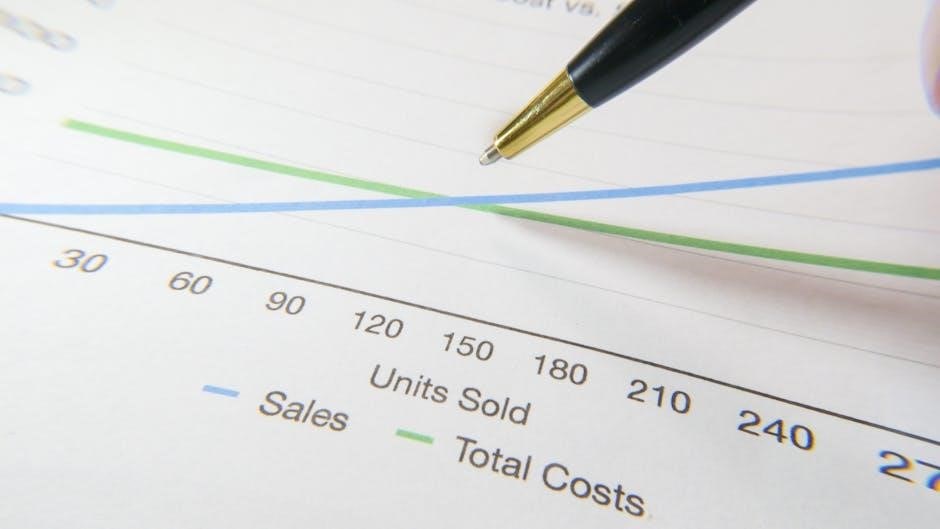
graphing periodic trends worksheet answers pdf
Understanding periodic trends is essential for analyzing atomic properties like radius, ionization energy, and electronegativity. Worksheets and graphs help visualize these patterns, aiding chemistry students in mastering these concepts effectively.
Importance of Periodic Trends in Chemistry
Periodic trends are fundamental in chemistry as they reveal patterns in atomic properties across the periodic table. Understanding these trends is crucial for predicting how elements behave in chemical reactions. By analyzing properties like atomic radius, ionization energy, and electronegativity, chemists can explain the periodicity of elements and their interactions. These trends also help in understanding the structure of matter and the formation of compounds. Worksheets and graphing exercises are essential tools for visualizing these patterns, making complex concepts more accessible to students. Mastery of periodic trends enhances problem-solving skills and provides a deeper appreciation of chemistry’s underlying principles. They are indispensable for advancing both theoretical and applied chemistry, making them a cornerstone of chemical education.
Key Properties to Graph: Atomic Radius, Ionization Energy, and Electronegativity
Atomic radius, ionization energy, and electronegativity are three critical properties studied in periodic trends. Atomic radius measures the size of an atom, ionization energy reflects the energy required to remove an electron, and electronegativity indicates an atom’s ability to attract electrons. Graphing these properties against atomic number reveals clear patterns across periods and groups. Atomic radius decreases across a period due to increasing nuclear charge but increases down a group as electron shells are added. Ionization energy generally rises across a period but drops down a group, while electronegativity follows a similar trend. These graphs help students visualize and understand the periodicity of elements. By analyzing these trends, chemists can predict chemical behavior and bonding tendencies, making these properties fundamental to chemistry education and research.

Understanding Atomic Radius Trends
Atomic radius trends reveal how atom sizes change across periods and groups. Understanding these patterns helps explain periodicity and chemical behavior, essential for chemistry studies and analysis.
Trends in Atomic Radius Across a Period
Atomic radius decreases as atomic number increases across a period. This trend occurs due to increasing nuclear charge and electrons being added to the same principal energy level, which pulls electrons closer to the nucleus. For example, in Period 3, the atomic radius of sodium is larger than that of chlorine; This pattern is consistent across all periods, with elements on the left side having larger atomic radii and elements on the right side having smaller ones. Graphing atomic radius vs. atomic number helps visualize this trend, showing a steady decline as you move from left to right across a period. This is a fundamental concept in understanding periodic trends and chemical properties.
Trends in Atomic Radius Down a Group
Atomic radius increases as you move down a group in the periodic table. This occurs because each element in a group has an additional principal energy level compared to the element above it. The increased number of electron shells results in a larger atomic size, despite the greater nuclear charge. For example, in Group 2A, the atomic radius of magnesium is smaller than that of calcium, which is smaller than that of strontium, and so on. Graphing atomic radius vs. atomic number for elements in the same group clearly shows this upward trend. This pattern is consistent across all groups, with atomic radius increasing progressively from top to bottom. Understanding this trend is crucial for predicting and explaining the chemical and physical properties of elements within a group.
Factors Affecting Atomic Radius
The atomic radius of an element is influenced by several factors, primarily nuclear charge and the number of electron shells. As atomic number increases across a period, nuclear charge rises, pulling electrons closer and reducing atomic radius. Conversely, down a group, additional electron shells are added, increasing the radius despite higher nuclear charge. Electron-electron repulsion also plays a role, though it is less significant than nuclear charge. These factors collectively determine the trends in atomic radius observed in the periodic table. Understanding these principles is essential for interpreting periodic trends and predicting atomic properties. By analyzing these factors, chemists can explain why atomic radius decreases across a period and increases down a group, providing a foundational knowledge of periodic behavior.

Graphing Atomic Radius
Creating bar graphs of atomic radius vs. atomic number helps visualize trends. Plotting Group 2A and Period 3 elements reveals patterns in atomic size across periods and groups.
Creating a Bar Graph of Atomic Radius vs. Atomic Number
To create a bar graph of atomic radius vs. atomic number, start by plotting atomic number on the x-axis and atomic radius on the y-axis. Use data for elements in a specific group or period, such as Group 2A or Period 3, to observe trends. Label both axes clearly and include a title for the graph. Ensure the scale on the y-axis is consistent to accurately represent changes in atomic radius. For Group 2A elements, the atomic radius increases down the group, while for Period 3 elements, the radius decreases across the period. Analyze the graph to identify patterns and exceptions, such as the smaller radius of noble gases. This visual representation helps students understand how atomic size varies systematically across the periodic table.
Plotting Group 2A Elements
When plotting Group 2A elements (alkaline earth metals) on a bar graph of atomic radius vs. atomic number, select elements such as magnesium (Mg), calcium (Ca), strontium (Sr), and barium (Ba). Place their atomic numbers on the x-axis and their corresponding atomic radii on the y-axis. Ensure the scale on the y-axis aligns with the data range for clarity. As you move down the group, the atomic radius increases due to the addition of new electron shells. This trend is consistent and demonstrates how atomic size grows with increasing atomic number. Label each bar clearly and include a legend if necessary. This graph helps visualize the systematic increase in atomic radius within Group 2A, reinforcing periodic trends in atomic properties. Compare this with trends in other groups to deepen understanding.
Plotting Period 3 Elements
For Period 3 elements, select a range such as sodium (Na) to argon (Ar). Plot their atomic radii on a bar graph with atomic numbers on the x-axis and radii on the y-axis. Ensure the scale is consistent and labels are clear. As atomic number increases across the period, atomic radius generally decreases due to increasing nuclear charge and electrons being added to the same principal energy level. This trend is evident from sodium to chlorine, with a slight deviation at argon. Include error bars if data variability exists. Annotate the graph to highlight the overall decreasing trend, noting any exceptions. This visualization aids in understanding how atomic size changes across a period, a fundamental concept in periodic trends. Compare with other periods to observe similarities and differences in atomic radius behavior.

Ionization Energy Trends
Ionization energy increases across a period due to greater nuclear charge and decreases down a group as electron shells increase. Noble gases have high ionization energy, while elements like oxygen and nitrogen show exceptions due to electron configurations.
Trends in Ionization Energy Across a Period
Ionization energy generally increases across a period as atomic number rises due to increasing nuclear charge and shrinking atomic radius. This trend reflects stronger attraction between nuclei and electrons in smaller atoms. However, exceptions occur, such as between oxygen and nitrogen, where oxygen has lower ionization energy despite being more electronegative. This anomaly arises from nitrogen’s stable half-filled p-orbital configuration, making it harder to remove an electron from oxygen. Similarly, elements like sulfur and chlorine show slight deviations due to orbital filling patterns. These exceptions highlight the importance of electron configuration in influencing ionization energy trends. By analyzing these patterns, students can better understand how atomic structure affects chemical properties.
Trends in Ionization Energy Down a Group
Ionization energy decreases as you move down a group in the periodic table. This trend occurs because atomic radius increases with higher periods, meaning outermost electrons are farther from the nucleus and more shielded by inner electrons. As a result, less energy is required to remove an electron from larger atoms. For example, in Group 1A, lithium has higher ionization energy than sodium, which in turn has higher ionization energy than potassium. This pattern holds for most groups, though exceptions may occur due to specific electron configurations. Understanding this trend helps in predicting the relative ease of ionization for elements within the same group, reinforcing how atomic structure influences chemical properties.
Factors Influencing Ionization Energy
Ionization energy is influenced by atomic radius, nuclear charge, electron shielding, and electron configuration. As atomic radius decreases across a period, ionization energy increases due to stronger attraction between nuclei and electrons. Conversely, down a group, larger atomic radius and increased shielding reduce ionization energy. Nuclear charge also plays a role, with higher charges generally leading to higher ionization energy. However, electron shielding can counteract this effect, as inner electrons reduce the effective nuclear charge experienced by outer electrons. Additionally, elements with stable electron configurations, such as noble gases, tend to have higher ionization energies. Exceptions occur, such as in Group 2A where beryllium has a higher ionization energy than boron due to its unique electron configuration. These factors collectively shape the trends observed in ionization energy across the periodic table.

Graphing Ionization Energy
Create a line graph plotting first ionization energy against atomic number. Analyze patterns, noting the general increase across periods and exceptions in Group 2A elements.
Creating a Line Graph of First Ionization Energy vs. Atomic Number
To create a line graph of first ionization energy vs. atomic number, follow these steps:
Label the x-axis as “Atomic Number” and the y-axis as “First Ionization Energy (kJ/mol).”
Plot each element’s atomic number on the x-axis and its corresponding ionization energy on the y-axis.
Connect the points with a smooth line to visualize the trend.
Highlight any exceptions or anomalies, such as lower ionization energies in Group 2A elements despite the general increase across a period.
Include a title and legend for clarity.
This graph helps in understanding how ionization energy changes across periods and groups, aiding in identifying periodic trends effectively.
Analyzing Patterns in Ionization Energy Graphs
When analyzing ionization energy graphs, observe the overall trend of increasing energy across a period due to rising nuclear charge and greater electron attraction. Note exceptions, such as lower ionization energies in Group 2A elements compared to Group 1A, due to their stable electron configurations. Down a group, ionization energy decreases as atomic size increases, making it easier to remove an electron. Identify peaks at noble gases and dips at alkali metals, reflecting their electron configurations. These patterns highlight periodicity and help predict properties. Use the graph to explain how trends relate to atomic structure and periodic table organization, reinforcing the relationship between ionization energy and periodic trends.

Electronegativity Trends
Electronegativity increases across a period and decreases down a group. It reflects an atom’s ability to attract electrons, influenced by nuclear charge and electron configuration.
Trends in Electronegativity Across a Period
Electronegativity generally increases across a period from left to right. As atomic number rises, nuclear charge increases, strengthening the atom’s pull on electrons. This trend is consistent because each element in a period has one more proton than the previous, enhancing its electron-attracting ability. For example, in Period 3, electronegativity increases from sodium to chlorine. However, noble gases like argon show a slight dip due to their full electron configuration, reducing their need to attract electrons. This pattern helps predict chemical behavior, such as reactivity and bond characteristics, making it a fundamental concept in understanding periodic trends.

Trends in Electronegativity Down a Group
Electronegativity decreases down a group due to increasing atomic size. As elements descend, the valence electrons are farther from the nucleus, reducing the atom’s ability to attract electrons. For example, in Group 17 (halogens), electronegativity decreases from fluorine to iodine. Larger atoms have weaker nuclear charge relative to their size, making it harder to attract electrons. However, this trend is not absolute; minor exceptions exist due to specific electron configurations. Understanding this trend helps predict bond polarity and chemical reactivity, emphasizing the importance of periodic trends in chemistry. This pattern aligns with atomic radius trends, where atoms grow larger down a group, further explaining the decrease in electronegativity.
Factors Affecting Electronegativity
Electronegativity is influenced by atomic size and nuclear charge. Smaller atoms with higher nuclear charges tend to have higher electronegativity. As atomic size increases down a group, electronegativity decreases because valence electrons are farther from the nucleus. Conversely, across a period, increasing nuclear charge enhances electronegativity. Electron configuration also plays a role; elements with nearly complete valence shells, like noble gases, exhibit high electronegativity. Additionally, the presence of d-orbitals in transition metals can influence electronegativity trends. These factors collectively determine how strongly an atom attracts electrons in a bond, shaping periodic trends in electronegativity across the periodic table.
Graphing Electronegativity
Plot electronegativity vs. atomic number to visualize trends. Observe increases across periods and decreases down groups. Compare these trends with atomic radius patterns for deeper insights.
Creating a Graph of Electronegativity vs. Atomic Number
To create a graph of electronegativity vs. atomic number, start by listing elements in order of increasing atomic number. Plot atomic number on the x-axis and electronegativity on the y-axis. Use data from periodic tables or provided worksheets. Mark each element’s electronegativity value as a point on the graph. Connect these points to observe trends. Across a period, electronegativity generally increases, while down a group, it decreases. Highlight notable exceptions, such as oxygen having higher electronegativity than nitrogen. This visual representation helps in analyzing and predicting periodic trends effectively for chemistry students.
Comparing Electronegativity Trends with Atomic Radius Trends
Electronegativity and atomic radius exhibit opposite trends across periods and groups. As atomic number increases across a period, electronegativity rises while atomic radius decreases. This inverse relationship occurs because stronger nuclear charge pulls electrons closer, reducing atomic size but increasing attraction for electrons. Down a group, atomic radius increases while electronegativity decreases due to the addition of electron shells, which reduces the nucleus’s pull on outermost electrons. Comparing these trends helps students understand how electron configuration and nuclear charge influence periodic properties. For example, oxygen has higher electronegativity but a smaller atomic radius than nitrogen, despite being in the same period. Such comparisons deepen the understanding of periodic patterns and exceptions, enhancing analytical skills in chemistry. Worksheets and graphs are essential tools for visualizing and interpreting these relationships effectively.

Ionic Radius Trends
Ionic radius trends reveal how ion sizes change across periods and groups. Cations shrink and anions expand compared to parent atoms due to electron loss or gain, influencing periodic patterns.
Trends in Ionic Radius Across a Period
Across a period, ionic radius generally decreases as atomic number increases. This trend is due to increasing nuclear charge, which pulls electrons closer, reducing ion size. For example, in Period 3, the ionic radius of cations like Na⁺, Mg²⁺, and Al³⁺ decreases from left to right. Similarly, anions like O²⁻ and F⁻ show a decrease in size due to the same nuclear charge effect. This pattern helps in predicting ionic sizes based on an element’s position in the periodic table. Understanding these trends is crucial for chemistry students analyzing periodic properties and graphing ionic radius vs. atomic number.
Trends in Ionic Radius Down a Group
Down a group, ionic radius generally increases due to the addition of new electron shells. For example, in Group 1, Li⁺ < Na⁺ < K⁺ < Rb⁺ < Cs⁺, showing a clear increase in ionic size. This trend is consistent for both main-group cations and anions, as the extra electron shells outweigh the increasing nuclear charge. However, hydrogen, being anomalous, does not follow this trend. Understanding this pattern helps in predicting ionic sizes based on an element's position in the periodic table, which is essential for graphing ionic radius trends accurately in periodic trends worksheets.
Factors Influencing Ionic Radius

The size of an ionic radius is influenced by several factors, including the principal quantum number, nuclear charge, and electron configuration. As elements move down a group, the principal quantum number increases, leading to larger ionic radii due to the addition of new electron shells. Nuclear charge also plays a role; lower nuclear charge results in larger ions because the nucleus exerts less attraction on the electrons. Additionally, ions with the same electron configuration (isoelectronic ions) can vary in size based on differences in nuclear charge. For example, smaller ions like O²⁻ are more charged than larger ions like S²⁻, despite having the same number of electrons. These factors are crucial for understanding and graphing ionic radius trends in periodic trends worksheets, as they explain why certain patterns emerge across the periodic table.

Graphing Ionic Radius
Plot ionic radius against atomic number to visualize trends. Ensure axes are labeled clearly, with ionic radius on the Y-axis and atomic number on the X-axis. Maintain consistency in scale and data representation to accurately reflect periodic patterns.
Creating a Graph of Ionic Radius vs. Atomic Number
To create a graph of ionic radius vs. atomic number, begin by labeling the x-axis as “Atomic Number” and the y-axis as “Ionic Radius (pm).” Plot the data points for selected ions, ensuring accuracy in their placement. Use a consistent scale to maintain clarity. Include elements from the same period or group to observe trends. For example, plot the ionic radii of cations and anions, noting how they increase or decrease across a period or down a group. Highlight isoelectronic series to compare ions with the same electron configuration. Analyze the graph to identify patterns, such as the general increase in ionic radius down a group due to additional electron shells. Discuss exceptions caused by electron configuration or charge effects. This exercise helps visualize and understand periodic trends in ionic radii effectively.
Analyzing Ionic Radius Trends in Relation to Atomic Radius
Analyzing ionic radius trends in relation to atomic radius reveals key insights into periodic patterns. As atomic number increases across a period, atomic radius decreases due to greater nuclear charge. Ionic radii, however, show distinct trends. Cations generally have smaller radii than their parent atoms, while anions are larger due to electron gain. Trends in ionic radii often mirror atomic radius trends but with variations due to ionization and electron configuration. For example, isoelectronic ions exhibit similar radii despite differing nuclear charges. Exceptions arise, such as smaller radii for ions with higher effective nuclear charge. Comparing these trends helps explain periodic behavior and the effects of electron configuration on ionic size. This analysis enhances understanding of how atomic structure influences ionic properties across the periodic table, providing a comprehensive view of periodic trends.
Periodic trends provide insights into atomic properties, with graphing essential for visualizing patterns. Worksheets and answer keys offer practical tools for mastering these concepts; Additional resources include online guides and practice problems for further exploration.


Leave a Reply
You must be logged in to post a comment.